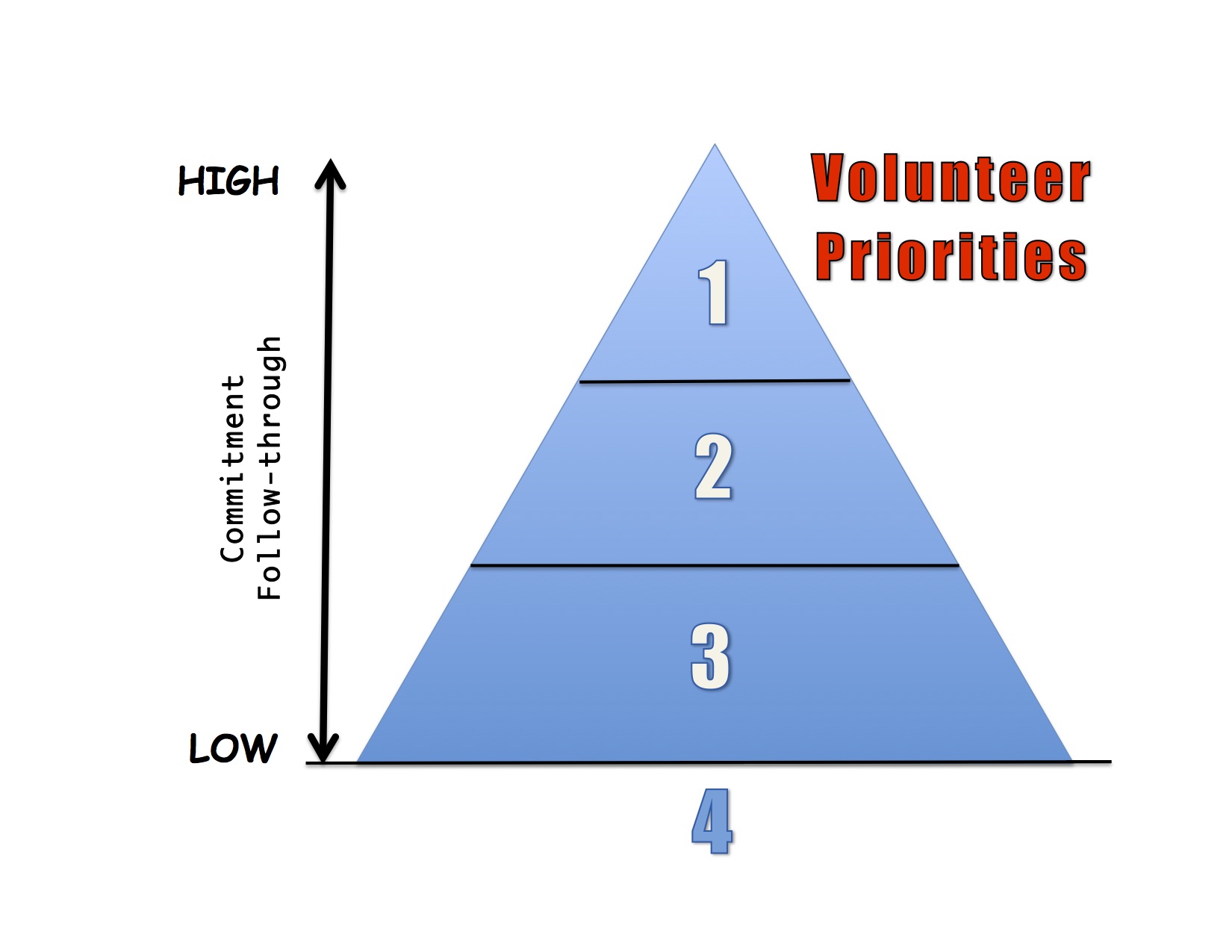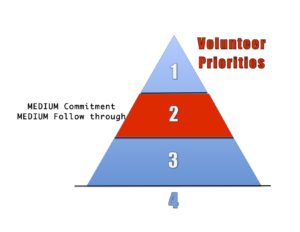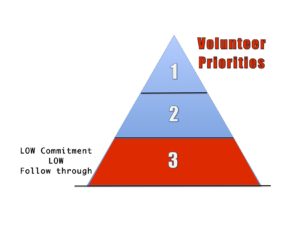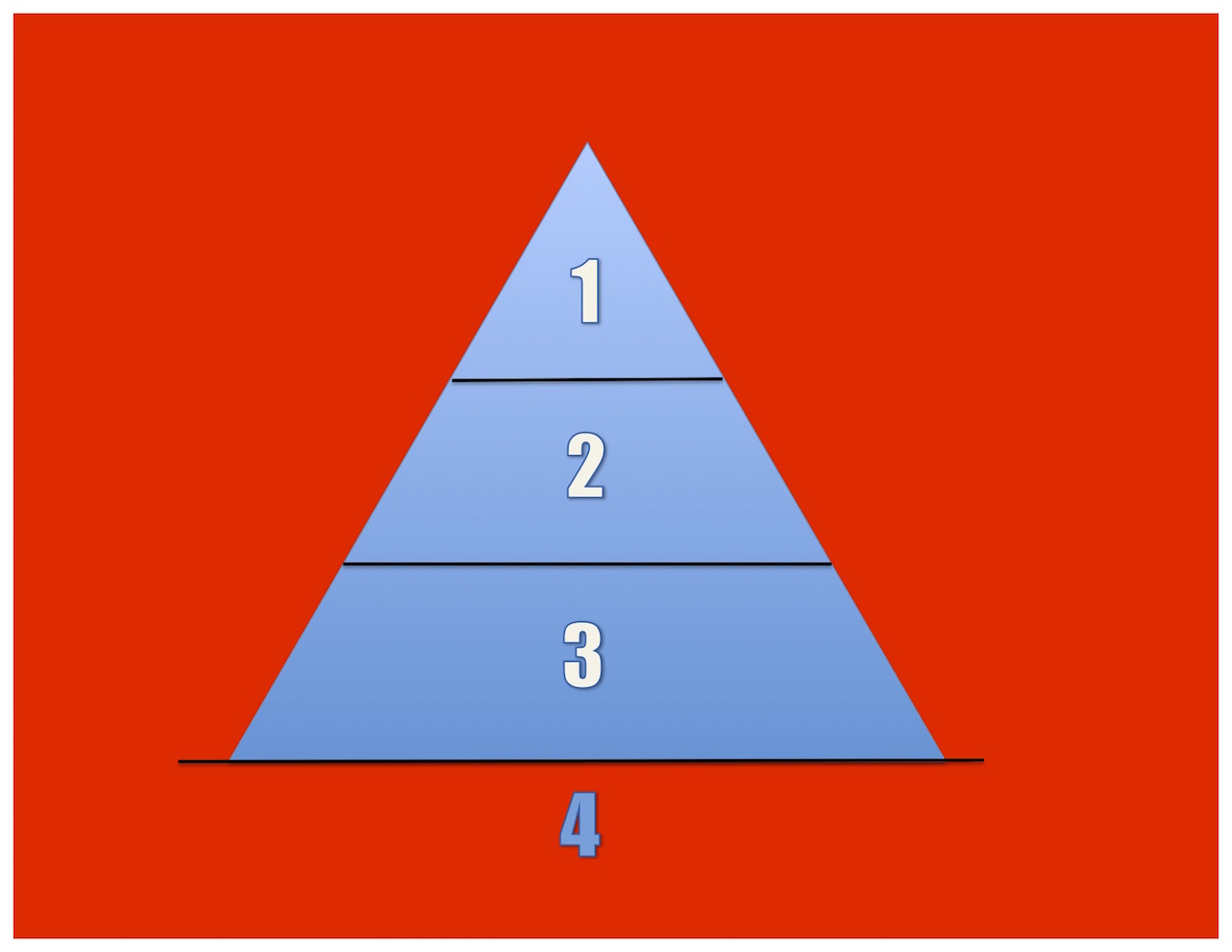3 Ways Volunteers View Your Project
3 Ways Volunteers View Your Project
Volunteers make up the life-blood of any non-profit organization. Although volunteers are essential, it’s important to note: not all volunteers are created equal. Some are great and contribute significantly. Others become like mythical creatures we’ve heard existed but have never actually seen ourselves. But, leaders can better work with volunteers if we determine what level priority your volunteer is giving your project. Because our time is finite, a volunteer can not give equal time and energy to every project or group they’re engaged in. A volunteer will have to decide if soccer practice or PTA will win if competing for the same time. I believe there are three main levels of priority and would like to explain each. As you read through these, think about everything you give time to in a week. Then consider which are the level 1,2, and 3 priority activities. Then consider whatever group you lead and what level priority your team members are giving your group.
 LEVEL 1
LEVEL 1
 I have a theory that, outside of work, everyone has room for only 1-3 activities considered level 1. These are the activities that get top priority in your life. They go on our calendar first. If there are two events scheduled at the same time, your level 1 priority activity will always win out. When something’s a level 1 priority in your life you will sacrifice your time, energy, and money to help it succeed. You know something’s a level 1 priority in your life when you’re on the board, organize the bake sale, or lead the group. You might even proudly showcase a sticker devoted to this group on the back of your van. You feel a certain level of personal ownership over the success of the organization. When you refer to the organization, you use sentences like, “we need to”, instead of “they need to.” If something’s a level 1 priority in your life then you’re “all in”. I don’t believe a person can healthily carry more 2 or 3 major level 1 activities at a time.
I have a theory that, outside of work, everyone has room for only 1-3 activities considered level 1. These are the activities that get top priority in your life. They go on our calendar first. If there are two events scheduled at the same time, your level 1 priority activity will always win out. When something’s a level 1 priority in your life you will sacrifice your time, energy, and money to help it succeed. You know something’s a level 1 priority in your life when you’re on the board, organize the bake sale, or lead the group. You might even proudly showcase a sticker devoted to this group on the back of your van. You feel a certain level of personal ownership over the success of the organization. When you refer to the organization, you use sentences like, “we need to”, instead of “they need to.” If something’s a level 1 priority in your life then you’re “all in”. I don’t believe a person can healthily carry more 2 or 3 major level 1 activities at a time.
Level 2
 Level 2 priority activities still carry a high level of commitment in our lives. These are the activities we care about, but only want to sacrifice so much. We’ll try to be at all the meetings, but level 1 activities can easily win-out our time. We care about the group or organization succeeding and are willing to passionately contribute ideas. But, we are only willing to give minimal effort to seeing those ideas develop.
Level 2 priority activities still carry a high level of commitment in our lives. These are the activities we care about, but only want to sacrifice so much. We’ll try to be at all the meetings, but level 1 activities can easily win-out our time. We care about the group or organization succeeding and are willing to passionately contribute ideas. But, we are only willing to give minimal effort to seeing those ideas develop.
Level 3
 Level 3 priority activities are those we’re involved in, but give the least priority. We’ll put the meeting on the calendar, but anything will make us miss the meeting. This can include, sleeping in, being tired, getting off a little late from work, needing to cut the grass, or really any “valid” excuse a person can find for not attending. When it comes to serving on projects given a level 3 priority, a person is glad to serve, but only to the extent that serving doesn’t interfere with their ongoing life too much. If a person has too many level 3 priorities in their life, it might be an indication that they have trouble saying no to things they don’t really want to do. If you only have a bunch of level 3 priority activities in your life, I might suggest your holding back and not giving making use of your God-given talents. No, you don’t have to suddenly make something a level 1 priority, but you can at least dive in a little deeper somewhere.
Level 3 priority activities are those we’re involved in, but give the least priority. We’ll put the meeting on the calendar, but anything will make us miss the meeting. This can include, sleeping in, being tired, getting off a little late from work, needing to cut the grass, or really any “valid” excuse a person can find for not attending. When it comes to serving on projects given a level 3 priority, a person is glad to serve, but only to the extent that serving doesn’t interfere with their ongoing life too much. If a person has too many level 3 priorities in their life, it might be an indication that they have trouble saying no to things they don’t really want to do. If you only have a bunch of level 3 priority activities in your life, I might suggest your holding back and not giving making use of your God-given talents. No, you don’t have to suddenly make something a level 1 priority, but you can at least dive in a little deeper somewhere.
Level 4
I mention level 4, just for comparison. These are the activities a person will give zero time, energy, and effort to. This is the free community class a person signs up for, but never attends. If you have a volunteer giving level 4 priority to your group, then don’t spend too much energy going after them. Reach out once, then move on.
Why Levels Matter
Personally, if you feel overwhelmed in your life, there’s a good chance you have too many activities your giving level 1 or level 2 priority to in your life. Also, it’s important to understand that there’s no right level. Do not feel bad giving book club a level 3 priority while giving PTA a level 1 priority. Every group will want or sometimes even expect to be a level 1 priority in your life, but that’s just not possible. Groups need to understand that, in order for people to be healthy, they have to give the appropriate level of commitment to each activity in their life. When you join any group, maybe let the leader know what level you’ll be giving the group- especially if it’ll be a level 3 for you.
Application for Leaders
As leaders, we must walk the line between respecting the priority level volunteers give our group, while at the same time encouraging deeper involvement. If a volunteer only wants to make your organization a level 3 priority in their life, then make sure to move them to an opportunity that only requires level 3 commitment. But, one of the most common reasons a person doesn’t offer more of their time and talents is because they are never asked. People like to be personally asked. They must have the freedom (and feel the freedom) to say no, but they want to be asked. If you have a level 3 volunteer in your group, consider asking them to help a little more. Also, if a person signs up to volunteer for a group, be clear about expectations. Some volunteer activities naturally require a level 2 priority. If you’re signed up to read to kids at an elementary school, then that teacher is depending on you to be there. If a volunteer opportunity requires more investment, let the potential volunteer know that up front. Considering priority levels can help leaders and volunteers in all kinds of ways.
One Note About Work: Sometimes a person’s work will suck all of their energy and time, taking away from any potential free time. In this scenario their work will become their main level 1 priority. This is neither good nor bad, it’s just worth acknowledging that this can be the case.
